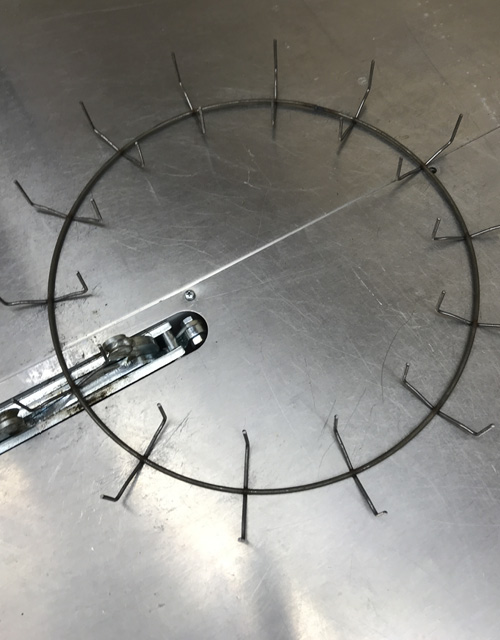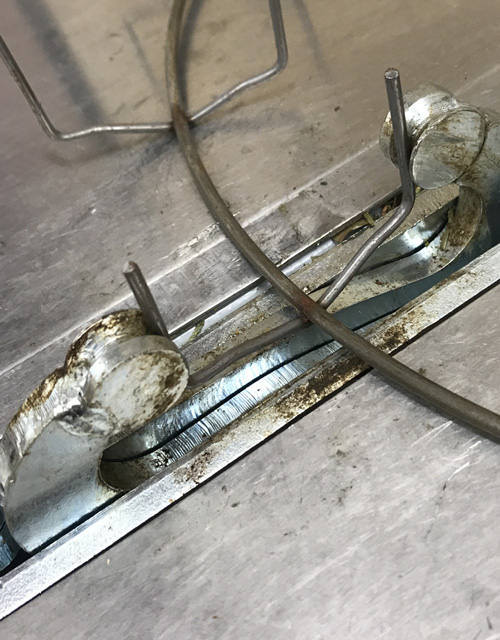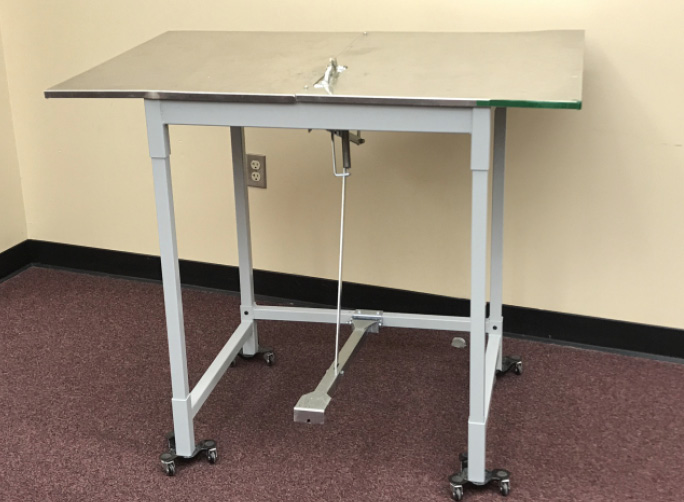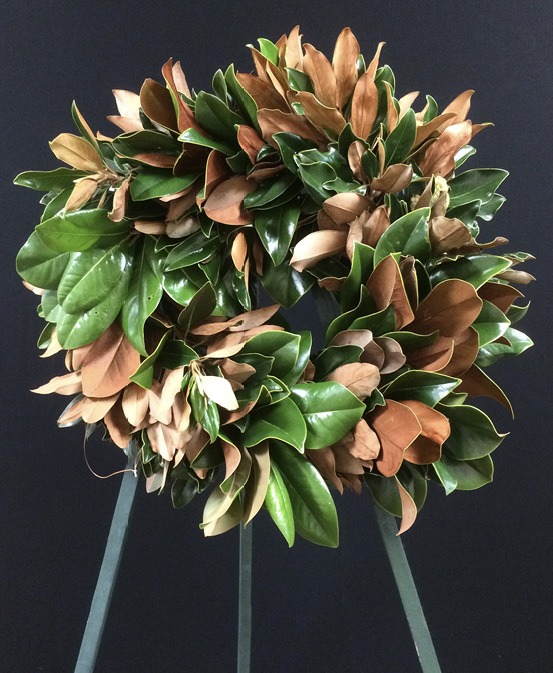Magnolia Wreath (Magnolia grandiflora) for the Farmer Florist
A wreath made from fresh magnolia leaves says “welcome” unlike any other floral decoration. The glossy, light-reflecting leaf tops beautifully contrast with their fine, suede-like undersides.
Magnolia wreaths are beautiful on the front door of a home, on a mantel, or in other focal areas in homes and businesses. They are often displayed during the holiday season, but they make a tasteful statement at any time of the year.
This publication focuses on magnolia production and forming magnolia leaves into a classical wreath shape. These wreaths are sought after by consumers, retail florists, and wholesale floral suppliers.
Production
With a native range encompassing the southeastern United States from Maryland to Florida and west to Texas, southern magnolias are a core element in many southern landscapes. Southern magnolias can be grown in a variety of environmental conditions, although they prefer acidic and moist but well-drained soils. Numerous cultivars of southern magnolia are available today, and mature heights can range from more than 50 feet for ‘D.D. Blanchard’ or ‘Bracken’s Brown Beauty’ to the much smaller ‘Little Gem’ or ‘Teddy Bear’.
Although best known for their beautiful, gently fragrant, creamy-white flowers during spring and summer, the evergreen foliage of southern magnolias provides texture and contrast to the landscape. The leaves are large and glossy with dark green upper surfaces and often fuzzy, brown undersides. These characteristics make southern magnolia an excellent choice for wreath-making. Farmer florists can take advantage of southern magnolias by offering both cut materials and finished wreaths to customers.
While materials can be sourced from established native stands or landscapes, you can easily establish and maintain southern magnolias on the farm to maximize plant growth and profit. Southern magnolias can be incorporated into the farm landscape as single specimen plants, as hedges separating various sections of the farm or property boundaries, or even as espaliers. Larger southern magnolias such as ‘D.D. Blanchard’, ‘Bracken’s Brown Beauty’, or ‘Claudia Wannamaker’ make excellent specimen trees in the landscape. Smaller southern magnolias such as ‘Little Gem’, ‘Teddy Bear’, or ‘Alta’ can be used as small specimen trees or grown in a line as a hedge. Any southern magnolia can be grown as an espalier, but this method requires more labor. Consider planting several different southern magnolia cultivars because leaf shapes and amounts of leaf fuzz vary and influence the character of the finished product.
Containerized southern magnolias can be established on the farm any time of the year. Balled and burlapped southern magnolias are usually transplanted from late summer to early fall. Make the planting hole at least 1½ to 2 times the diameter of the root ball and equal to or slightly less than the height of the root ball. Make sure that the basal flare of the trunk is visible above the soil line. Backfill the planting hole with native soil, making sure to break apart any clumps. Irrigate after transplanting and as needed throughout the year. Do not fertilize when plants are first transplanted; however, fertilization in subsequent years based on soil test recommendations may encourage vigorous growth.
Harvest and Handling
Harvest magnolia stems (8 to 24 inches long) after new growth has matured. Look for branches with plenty of leaves and remove any flowers. Avoid soft, springtime growth because it will quickly wilt. It is best to keep cut magnolia branches cool and moist once they are harvested. If there is a large gap (days) between harvest and design construction, keep stems in fresh flower food solution, in waxed boxes, or wrapped in vinyl sheets/bags. If you use sheets/bags, be sure to vent stored bundles by poking holes into the plastic. Moist, still air harbors gray mold (Botrytis cinerea) as well as other pathogens that can lower magnolias’ quality in storage. Store magnolias in water and refrigerate for up to 6 weeks.
Design Construction
Prune magnolia stems to approximately 14-inch lengths. It takes about 3 pounds of these stems to produce one wreath. The wreath shown on the next page was made on a 14-inch-diameter frame. The finished design has a 24-inch outside diameter and takes about 30 minutes to construct using a clamping-type wreath machine.
The wreath frame has wire prongs that hold loose bunches of plant material. The machine uses force to clamp the prongs around a cluster of about four to six stems, holding them tightly in place. The clamping action is operated by a foot pedal, leaving your hands free to hold materials in place. Having the clamp mechanism permanently attached to a table is a best practice for commercial producers and a good choice for producers entering the wreathmaking marketplace.
Purchasing the cut magnolia to make this design from a wholesale florist would cost around $40. Our study found that consumers are willing to pay less than that figure, on average about $32. However, this cost difference should not be the deciding factor because magnolia wreaths retail at much higher prices. You can grow the materials yourself, manufacture and market these wreaths, and maintain a profit.




References
Dirr, M. (1998). Manual of woody landscape plants. Stipes.
Hudson, D., and Griffin, E. (2004). Market potential for “Mississippi grown” cut flowers. Mississippi Agricultural and Forestry Experiment Station Bulletin 1140, Mississippi State University.
Posadas, B. C., and Del Prince, J. (2019). Consumer preferences and willingness to pay for wreath designs. Mississippi Agricultural and Forestry Experiment Station Bulletin 1227, Mississippi State University.
The information given here is for educational purposes only. References to commercial products, trade names, or suppliers are made with the understanding that no endorsement is implied and that no discrimination against other products or suppliers is intended.
Publication 3553 (POD-11-23)
By James DelPrince, PhD, Associate Extension Professor, Coastal Research and Extension Center; Ben Posadas, PhD, Extension/Research Professor, Coastal R&E; Patricia Knight, PhD, Research Professor and Director of Coastal Horticultural Research, South Mississippi Branch Experiment Station; and Christine Coker, PhD, Extension/Research Professor, Coastal R&E.
The Mississippi State University Extension Service is working to ensure all web content is accessible to all users. If you need assistance accessing any of our content, please email the webteam or call 662-325-2262.




